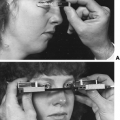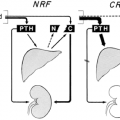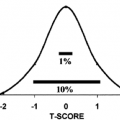BARTTER SYNDROME
Part of “CHAPTER 80 – HYPERALDOSTERONISM“
CLINICAL FEATURES AND PATHOPHYSIOLOGY
Bartter syndrome includes a number of disorders of tubular transport that may be familial or acquired as a result of a disease such as cystinosis.69,70 The syndrome may present in childhood as a failure to thrive, weakness, salt craving, polyuria, and polydipsia, or in adulthood as an incidental finding with little associated symptomatology. In the latter instance, the syndrome may have been present since childhood in a mild form that was not detected. Serum chloride and potassium levels are low and serum carbon dioxide content is normal or increased. The serum magnesium concentration may be normal or low, and creatinine clearance may be normal or decreased.
Physiologic studies suggested that an impairment of chloride transport in the diluting segment of the nephron, presumably the thick ascending limb of the loop of Henle, was the cause of the syndrome in some patients.71 The defect in chloride reabsorption would impair the ability of the tubule not only to dilute, but also to concentrate tubular fluid, because it results in a decrease in medullary hypertonicity. A defect in chloride transport by the thick ascending limb also would decrease potassium reabsorption in this segment and stimulate its secretion distally by increasing the volume of tubular fluid delivered to the distal nephron, in which potassium secretion is flow-dependent.72 Molecular biology studies indicate that such patients may have a mutation in the gene encoding a renal chloride channel, CLCNKB.73 This channel represents a major pathway through which chloride travels from cells of the thick ascending limb across their basolateral membrane into the interstitium. Hypercalciuria may or may not be an associated finding.
The Na+-K+-2Cl– cotransporter also mediates the reabsorption of chloride, in addition to sodium and potassium, in the thick ascending limb.74 Mutations in the gene NKCC2 that encodes for this cotransporter produce a syndrome, apparent in the immediate postnatal period, characterized by failure to thrive, marked polyuria, and polydipsia.75 The delivery is frequently premature and complicated by polyhydramnios. Hypercalciuria is present and usually complicated by nephrocalcinosis and, presumably, is the basis for the impairment in urinary concentrating ability. Diluting ability appears to remain intact.
Mutations in the gene ROMK that encodes for a potassium channel, which are also located in the luminal membrane of cells of the thick ascending limb, produce a syndrome clinically similar to that produced by mutations in NKCC2.76 ROMK encodes for an ATP-sensitive potassium channel, which recycles potassium that has been reabsorbed from tubular fluid by thick ascending limb cells (from the cells back into the tubular lumen). This process of potassium recycling ensures sufficient luminal potassium for Na+-K+-2Cl– transporter to function. Thus, an impairment in function of this channel has physiologic consequences similar to those produced by mutations in NKCC2.
Stay updated, free articles. Join our Telegram channel

Full access? Get Clinical Tree






